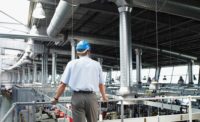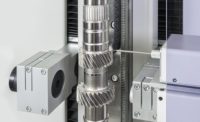The market for coordinate measuring machines (CMMs) is mature and, as such, experiencing low revenue growth rates. This has created a highly competitive environment, in which participants seek ways to maintain their current market share, while attempting to investigate new expansion opportunities. An emerging product category actively pursued by most market participants is that of shop-floor CMMs. This article will discuss the trend toward shop-floor measurement and analyze growth potential of the shop-floor CMM market.
Why Shop-floor Measurement?
There are many factors contributing to end users shifting toward shop-floor measurement, but most significantly is that of cost saving, according to sources in the industry.
“People are pushing in the direction of shop-floor measurement because they can save a lot of money by catching a problem or quality issue early in the manufacturing process,” says Jon Bumgardner, business development analyst at a U.S. based Mitutoyo subsidiary company.
Chris Davies, business development manager at Aberlink Innovative Metrology, agrees with this reasoning. He says, “Putting CMMs by the side of machines where parts are actually being made in order to give a quick verification that the process outcome is correct is perhaps the single biggest driving factor behind the shift towards floor-shop measurement.”
To put things in perspective, in high-speed production environments 1,000 incorrect parts may be manufactured in the time it takes to transport a single part to the lab for measurement. This constitutes a huge amount of waste in material and time.
There has also been a trend towards lower tolerances. “We live in a world where there is a push to reduce tolerances across all industries driven by demand for increased efficiency and longer product life cycles,” says Elliot Mills, general manager at Coord3 Metrology. “This is driving process feedback which can be achieved with shop-floor measurement.”
What Are the Tools for Shop-floor Measurement?
There is an undeniable trend toward shop-floor measurement due to the significant cost saving achieved; however, CMMs are not the only tool for shop-floor measurement. Traditional ways of measuring on the shop-floor include customized hard gages, fixtures and hand tools, although there is a trend toward using shop-floor CMMs.
“What we are finding is that the traditional ways of gaging on the production floor are custom designed, singular in purpose and specific to product under production,” says Arthur Whistler, vice president of sales and marketing at Helmel Engineering Products Inc. “They require setting masters, which in certain applications, may cost around $300K to $350K. This is significantly more expensive than the cost to calibrate CMMs.”
Furthermore, Marcin Bauza, director of new technology and innovation at Carl Zeiss Industrial Metrology, considers the capital cost for hard gages, complexity of modern parts and possible operator error to be driving factors toward adoption of shop-floor CMMs.
“A gage bench equipped with all the right gages can incur a capital expenditure of up to $100K apart from the cost of gage replacement and maintenance,” says Bauza. “If you consider the number of gages required to measure all features, $100K is the realistic cost you are looking at.”
Frost & Sullivan finds that a typical shop-floor CMM costs significantly lower than the average cost of a customized hard gage bench. Considering the vast difference in cost between a CMM and the hard gage bench, CMMs should be the preferred choice for shop-floor inspection. However, there are still companies that continue to use hard gages due to the challenges associated with using a CMM on the shop-floor or disbelief that this technology is shop floor ready.
Why Are CMMs Currently Not the Preferred Tool for SHOP-FLOOR MEASUREMENT?
“Compensating for the production environment conditions is perhaps the most challenging aspect of using a CMM on the shop floor. The temperature variation, air quality and power to the machines on a shop floor are all important factors to consider,” says Mills.
This can be extremely challenging in regions that experience extreme temperatures. “In countries like India, temperature variation and humidity are a major challenge,” says Davies. “The temperature on a shop floor may change considerably from morning to night and without proper thermal compensation, the accuracy of the CMM is in question.”
Air quality is of supreme importance for CMMs operating on an air bearing structure. Any dust particle on the granite supporting this bearing structure can damage the bearing over time. However, these are not the only challenges associated with shop-floor CMMs.
“Ambient temperature variation and air contamination are just the tip of the iceberg. There can be workpiece temperature variations and floor vibration which affect the accuracy of CMMs,” says Bumgardner. “You may be able to compensate for ambient temperature fluctuations at the frame of the CMM, but it is difficult to compensate for temperature variations of the part.”
Even though the CMM may be calibrated at a particular temperature, the temperature variation of the part will affect the measurement results. Whistler expanded further: “The control over the temperature on a floor argues for more thermal compensation, but in reality you may have parts that reach the CMM a little warm. Hence, unless you are doing real time thermal modeling either in-process or post-process, there is some wishful thinking about thermal compensation.”
Nonetheless, challenges associated with the environment conditions on a shop floor do not outweigh the benefits of shop-floor CMMs. Beyond the previously mentioned benefits, shop-floor CMMs also fit perfectly with the concept of lean manufacturing, the practice of eliminating scrap as early as possible in the production process. This provides further cost saving and significant efficiency to the production process.
Shop-Floor CMM Market Overview
To understand the shop-floor CMM market, it is important to first define various product segments. The shop-floor CMMs can be broadly classified into inline and semi-inline CMMs. Inline CMMs are extremely automated systems that are designed to be integrated with an automated production line. These systems need to provide high-speed inspection of the manufactured parts. Examples of these solutions are Mitutoyo’s Mach V and Ko-ga-me, Helmel’s Cellmaster, Carl Zeiss’s scanning CMMs such as CenterMax, GageMax, DuraMax, O-inspect and VoluMax representing in-line structural measurements (CMM with CT sensor). On the other hand, semi-inline CMMs are designed to be placed next to a production line. These systems may be automated or require an operator to place the manufactured part from the production line on the CMM for measurement. Furthermore, the semi-inline CMMs can be subdivided into true CMMs and the gaging solutions. The gaging solutions operate similar to gages and compare the manufactured part to a master part. Renishaw’s Equator is currently one of the most prominent products in this sub-segment.
Unlike the gaging solutions, true CMMs provide the actual dimensions of the part being measured.
Presently, the shop-floor CMM segment is a small percentage of the total CMM market. But this segment is growing at a rapid pace and the potential for growth over the long term is immense. Currently, the industries that have accepted this trend towards inspection on the shop-floor are the automotive and aerospace industry. However, it is expected that other end users will eventually go towards shop-floor metrology within the next five to seven years.
Carl Zeiss has been supportive of the idea to bring CMMs to the shop-floor environment. The company has a complete range of both inline and semi-inline scanning CMMs with DuraMax and O-inspect being its flagship products in this segment. Competitors such as Mitutoyo, Helmel, Coord3, Aberlink and Wenzel also offer shop-floor CMMs. Hexagon Metrology showcased the 4.5.4 SF early this year to serve as a direct competitor to the DuraMax, although the product has not been launched internationally.
Is this the next big opportunity for CMMs?
Although the shop-floor CMM market is currently small, the growth potential it possesses is limitless. According to the industry statistic sampler published by the U.S. Department of Commerce, there are 2,600 machine shops in the United States. Potentially, every machine shop is an end user for a shop-floor CMM. Besides the machine shops, every manufacturing plant is a potential end user. Depending upon the size of these machine shops and manufacturing plants, multiple units may be purchased. Considering this, the growth potential for shop-floor CMMs globally is evident.




